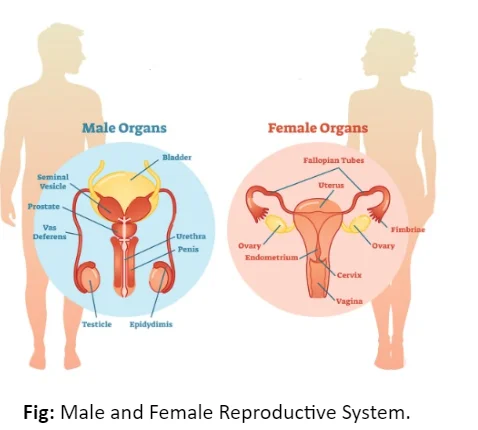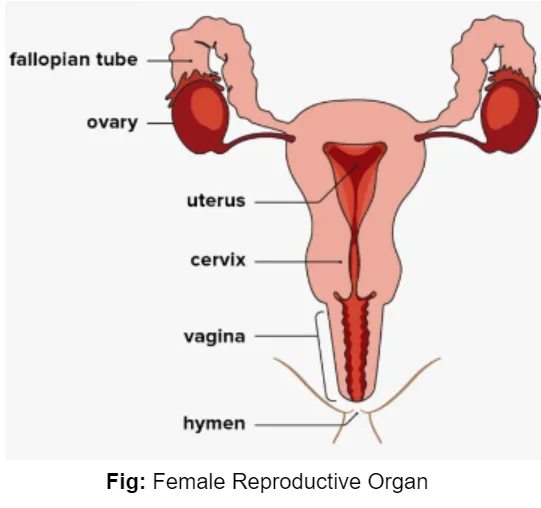The reproductive system in humans shows clear differences between males and females, both structurally and functionally. Its main role is to produce male and female gametes, sperm, and secondary oocytes, respectively. The male reproductive organs, such as the scrotum, penis, and testes, are mostly external. In contrast, the female reproductive organs, including the vagina, cervix, uterus, fallopian tubes, and ovaries, are internal and controlled by hormones like progesterone and estrogen.
Male Reproductive Organs
- The male reproductive system is characterised by the dominance of the associated anatomical structures located outside the body– the scrotum, penis and testes.
-
-
- The testes are located outside the abdominal cavity in a pouch called the scrotum.
- The scrotum maintains a lower temperature (2-2.5°C below body temperature) needed for sperm production.
- Each testis is oval, about 4-5 cm long and 2-3 cm wide.
- Testes are covered by a dense layer and divided into 250 compartments called testicular lobules.

- Seminiferous Tubules and Cells
-
-
- Each testicular lobule contains 1-3 coiled seminiferous tubules where sperms are produced.
- Seminiferous tubules are lined by male germ cells (spermatogonia) that undergo meiosis to form sperm and Sertoli cells that provide nutrition to germ cells.
- Interstitial spaces outside the tubules contain:
-
-
- Blood vessels.
- Leydig cells that produce androgens (testicular hormones).
- Other immune cells.
-
-
- Include rete testis, vasa efferentia, epididymis, and vas deferens.
- Seminiferous tubules open into vasa efferentia through the rete testis.
- Vasa efferentia connect to the epididymis located on the posterior of the testis.
- The epididymis leads to the vas deferens, which ascends to the abdomen, loops over the bladder, and joins the seminal vesicle duct to form the ejaculatory duct.
- The ejaculatory duct opens into the urethra, which passes through the penis to the external opening (urethral meatus).
- Sperm Storage and Transport
-
-
- These ducts store and transport sperms from the testis to the outside through the urethra.
-
-
- The penis is the male external genitalia.
- It contains special tissue that aids in erection for insemination.
- The enlarged end is called the glans penis, covered by a loose fold of skin called the foreskin.
-
- Include paired seminal vesicles, a prostate, and paired bulbourethral glands.
- These glands produce seminal plasma, rich in fructose, calcium, and enzymes.
- Bulbourethral gland secretions help lubricate the penis.
Female Reproductive Organs
- Main Components: The female reproductive system includes ovaries, fallopian tubes, uterus, cervix, vagina, and external genitalia.

-
-
- Ovaries: Primary sex organs producing ova and steroid hormones. Located on each side of the lower abdomen, each ovary is 2-4 cm long, covered by epithelium, and connected to the pelvic wall and uterus by ligaments.
- Oviducts (Fallopian Tubes): About 10-12 cm long, extending from the ovaries to the uterus. Includes the infundibulum with fimbriae, the ampulla, and the isthmus.
- Uterus: Inverted pear-shaped organ, also known as the womb.
- Supported by pelvic ligaments, it opens into the vagina through the cervix. Its wall has three layers: perimetrium, myometrium, and endometrium.
- The uterus supports pregnancy and childbirth.
- Cervix and Vagina: Cervix connects the uterus to the vagina, forming the birth canal along with the cervical canal.
- External Genitalia: Includes mons pubis, labia majora, labia minora, hymen, and clitoris.
- External genitalia protect internal reproductive organs.
-
-
- Oviducts (Fallopian Tubes): Transport ova from ovaries to the uterus, includes:
- Infundibulum: Funnel-shaped, near the ovary with fimbriae.
- Ampulla: Wider middle section.
- Isthmus: Narrow section joining the uterus.
- Uterus: Layers of Uterus:
-
-
- Perimetrium: External thin membrane.
- Myometrium: Thick smooth muscle layer.
- Endometrium: Inner glandular layer, undergoes cyclical changes.
-
-
- Mons Pubis: Fatty cushion covered with skin and hair.
- Labia Majora and Minora: Fleshy folds surrounding the vaginal opening.
- Hymen: Membrane partially covering the vaginal opening.
- Clitoris: Small, sensitive structure at the upper junction of labia minora.
-
- Structure: Paired breasts with glandular tissue and fat.
- Function: Mammary glands produce and deliver milk for child care.
- Milk production and storage in alveoli, which open into mammary tubules and ducts.
- Milk Flow: From alveoli to mammary tubules, then to mammary ducts, mammary ampulla, and lactiferous duct for feeding.
- Puberty: It is the beginning of sexual maturity, which usually happens between ages 10 and 14 for girls and ages 12 and 16 for boys.
- It causes physical changes and affects boys and girls differently.
- Menstrual Cycle: It involves periodic (usually every 28 days) discharge of blood, tissue fluid, mucous, and epithelial cells that usually lasts for 4-5 days and is triggered by a sudden reduction in estrogens and progesterone.
- Menarche is defined as the first menstrual period in a female adolescent.
- Menopause (diagnosed after 12 months without a menstrual period in adult females) is the time that marks the cessation of menstrual cycles.
|
Conclusion
- Understanding the male and female reproductive systems highlights their roles in human reproduction.
- The male system focuses on sperm production and delivery, while the female system supports ovulation, fertilization, and childbirth.
- Puberty marks the beginning of sexual maturity, with physical changes in both boys and girls. The menstrual cycle regulates female fertility, from menarche to menopause.
- Awareness of these systems promotes better health and informed decisions about reproductive health.
![]() June 5, 2024
June 5, 2024
![]() 1149
1149
![]() 0
0

